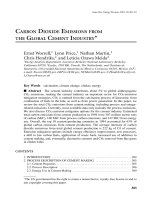Solar revolution the economic transformation of the global energy industry
Bạn đang xem bản rút gọn của tài liệu. Xem và tải ngay bản đầy đủ của tài liệu tại đây (4.69 MB, 255 trang )
m
o
.c
MD DALIM 856816 6/1/06 CYAN BLUE BLACK
w
w
w
G
e
h
T
.
ll
A
et
tA
ll.
co
Ge
he
w
.T
w
w
m
Solar Revolution
tA
ll.
co
Ge
he
w
.T
w
w
m
Solar Revolution
m
The Economic Transformation of the Global
Energy Industry
w
w
w
.T
he
Ge
tA
ll.
co
Travis Bradford
The MIT Press
Cambridge, Massachusetts
London, England
m
tA
ll.
co
© 2006 Travis Bradford
All rights reserved. No part of this book may be reproduced in any form by any
electronic or mechanical means (including photocopying, recording, or information storage and retrieval) without permission in writing from the publisher.
Ge
MIT Press books may be purchased at special quantity discounts for business or sales
promotional use. For information, please e-mail <>
or write to Special Sales Department, The MIT Press, 55 Hayward Street, Cambridge, MA 02142.
he
This book was set in Sabon by SPI Publisher Services.
w
.T
Printed on recycled paper and bound in the United States of America.
Library of Congress Cataloging-in-Publication Data to come
w
w
Bradford, Travis.
Solar revolution : the economic transformation of the gloabal energy industry /
Travis Bradford.
p. cm.
Includes bibliographical references and index.
ISBN 0-262-02604-X—ISBN 978-0-262-02604-8 (hc : alk. paper)
1. Solar energy industries. 2. Solar energy—Economic aspects. 3. Solar
energy—Social aspects. 4. Power resources. I. Title.
HD9681.A2B73 2006
333.792'3—dc22
2006044432
Illustration and table credits can be found on page 223.
10
9 8 7 6 5 4 3 2 1
m
tA
ll.
co
To my parents—
Wayne, who taught me never to fear
honesty or hard work,
Ge
and
w
w
w
.T
he
Susan, who taught me never to fear
anything else.
tA
ll.
co
Ge
he
w
.T
w
w
m
ix
tA
ll.
co
Preface: The Future of Energy
Acknowledgments
xv
m
Contents
I The Inevitability of Solar Energy
1 A New Path on the Horizon
3
21
2 A Brief History of Energy
23
Ge
II Past to the Present
3 An Unsustainable Status Quo
89
67
w
.T
5 Solar Energy
45
he
4 The Field of Alternatives
1
III Future Transformations
113
6 Modern Electric Utility Economics
115
w
7 The Emergence of Distributed Economics
8 Solar Electricity in the Real World
w
IV A Promising Destination
9 Tools for Acceleration
10 Facing the Inevitable
135
153
169
171
185
Appendix: Energy and Electricity Measurements
Notes
201
Suggested Readings
221
Credits
223
Index
227
199
tA
ll.
co
Ge
he
w
.T
w
w
m
m
Preface: The Future of Energy
w
w
w
.T
he
Ge
tA
ll.
co
This is a book about the future of energy. Even without a deep analysis
of the energy industry, most people fundamentally understand that our
current energy system is ultimately unsustainable and that renewable
energy (including solar energy) will be an inevitable part of our common
future. Global economic, environmental, and social pressures are driving
our species and our economies to change how we harness vital energy,
and these pressures will intensify as we approach the middle of the
twenty-first century and expand to an estimated population of ten billion
inhabitants on the planet.
Many of the greatest hurdles we will face in the next fifty years will
be a direct result of how we currently and eventually decide to procure
the energy necessary to sustain our lives and our standard of living.
Human-induced climate change, resource wars over energy supplies,
and cycles of deforestation, famine, and poverty that result from our
insatiable appetite for energy are not new problems. Humans have
grappled with these problems for centuries. The difference today is that
these problems have accelerated in scale and potential repercussions to
global proportions.
Inevitably, the threats that our relationship to energy creates will be
mitigated when motivation and opportunity collide. This could happen
when businesses and government compensate for the risks and costs of
our current energy system with effective foresight and coordinated planning or, alternatively, when we are forced to change in response to a
1970s-style energy crisis. Whatever the catalyst, the industrialized and
developing nations of the world will eventually address these issues by
using energy more efficiently and by developing and deploying local, sustainable, renewable energy sources.
x
Preface
w
w
w
.T
he
Ge
tA
ll.
co
m
Many such energy-generation solutions are being pursued, including
nuclear power and renewable wind, biomass, and geothermal energies.
Businesses and policy makers are currently pursuing choices based on
their respective natural-resource endowments, technical expertise, and
political will. For example, Iceland is tapping into its vast stores of geothermal and hydroelectric energy in an attempt to become the world’s
first fossil fuel–free economy. The countries of northern and western
Europe (including the United Kingdom, Denmark, and Germany) are
taking advantage of their ample wind resources to lead the world in
wind-power deployment. Land-rich but oil-poor Brazil is deploying biofuels to power its transportation infrastructure at a lower cost than traditional gasoline or diesel fuel. Each of these developing energy sources
has a role to play worldwide, and many will be components of the solutions that are ultimately employed.
Various solar-energy-generation technologies—including direct electricity generation from photovoltaic (PV) cells—also continue to be researched
and deployed. Although PV technology is conceptually simple—harnessing
the sun’s energy on a solid-state device—generating electricity with PV cells
is generally assumed to be both too expensive and too far behind in terms
of market penetration to have a meaningful impact on the juggernaut of the
world energy infrastructure. Partially because of solar energy’s false promises in the 1970s, the technology is widely seen as a desirable but uncompetitive energy source in all but niche markets and remote small-scale
power applications. However, developments in the PV industry over the
last ten years have quietly transformed solar energy into a cost-effective and
viable energy solution today.
In many markets such as Japan, Germany, and the American
Southwest, PV electricity has already become the energy choice of hundreds of thousands of users. From this established base, the technology
of PV is poised to transform the energy landscape within the next decade
as relative prices of this technology versus existing sources make it
increasingly competitive. PV technology’s relative cost-effectiveness when
compared to traditional energy choices and even many of the “new
renewables” such as geothermal, wind, biomass, or ocean power will
ensure its continued market penetration. Although it will be many years
before solar energy provides a substantial amount of the world’s energy
generation, awareness of the inevitability of the solar solution will have
Preface
xi
w
w
w
.T
he
Ge
tA
ll.
co
m
a surprisingly dramatic impact on electric utilities, government policy
makers, and end users much sooner than most predict.
At its root, the shift to solar energy will be due to two complementary
economic drivers in the energy industry that affect the configuration of
energy supply and demand. The first driver relates to what types of
energy source are used to power modern industrialized and developing
economies. Pressure to develop sources of clean, renewable energy is
growing because of the increasing costs and risks of securing traditional
energy supplies, the increasing need for more energy as countries like
China and India industrialize, and a growing understanding of the environmental effects of traditional sources of energy.
The second driver relates to how and where energy is being generated.
Over the next few decades, industrial economies will shift away from
large, centralized energy production toward smaller, distributed energy
generators, primarily because end users will increasingly have costeffective options to avoid the embedded costs of the existing energy infrastructure. This trend toward distributed energy is also true for the
billions of people who live in developing economies (where most of the
global growth in energy use is projected to occur) and who do not currently have access to large, centralized electricity grids and distribution
systems. As these two drivers combine to change the economics of
energy, much of the world will find it economic to use locally generated,
clean, renewable energy. This book discusses the inevitable conclusion of
these two trends—when, where, and why they will occur.
The research that led to this book did not begin with the supposition
that such a clear energy path existed. It began with the broader question of where the natural momentum of the global energy industry has
been leading and what trends would determine its future. The
inevitabilities regarding solar energy became apparent only through an
understanding of the natural economic forces that were transforming
the industry, the changing relative costs and risks inherent in the various energy technologies, and the surprisingly close proximity of transition points for various energy users that would alter their decision
making. But while inevitability alone is an interesting concept, it is not
particularly useful without the answers to three pivotal questions:
when will this inevitability arise, what challenges stand in the way
between today’s status quo and the inevitable configuration, and is
xii
Preface
w
w
w
.T
he
Ge
tA
ll.
co
m
such inevitability desirable enough that efforts should be made to
accelerate it?
To answer these questions, this book examines the entire energy cycle
that dictates our relationship through energy to other people and to the
planet rather than just the energy infrastructure that utility providers and
fossil-fuel suppliers typically describe. Only by placing global energy use
in this greater context can we properly evaluate the decisions that we as
individuals and as a society will ultimately make. In determining which
energy options will prevail, a reasonable analysis must look beyond preconceptions about which one “should” succeed or which one would be
“the best” solution for society. Such analysis relies too much on wishful
thinking amid disparate and conflicting political and economic agendas.
Instead, responsible analysis should determine how, in the course of dayto-day life and trillions of individual uncoordinated decisions, energy
solutions will unfold naturally.
Forecasts of this nature are always risky. However, constructing models of the future is critical for sound decision making on important topics, and various forecasting approaches can be applied. Some people
build mathematical models, some use broad philosophy, and still others
take a business approach. The forecasts herein use a combination of economic and business modeling because, in the end, the relevant question
is how the global energy industry and its economic agents will behave.
In business, when managers are attempting to forecast market conditions
over long periods of time, specific forecasts are not always possible or
even useful. Understanding and predicting key market drivers and the
ways that they will change over time are how the underlying tectonic,
and eventually determinative, forces are detected. Correctly assessing
these key drivers and using them to economic advantage is what separates highly successful businesspeople from the pack. When the key drivers in the global energy industry are identified, they expose the fallacy of
the conventional logic that states that solar power is destined to be a
marginal player in our energy future.
The inevitability of solar power itself is a powerful concept, and a
clear vision of the inevitable will help guide decision making today and
in the years ahead. Although the size of the existing energy infrastructure
and the long life of the assets employed may mean that it will be many
years before the world is dominated by clean, virtually unlimited solar
Preface
xiii
w
w
w
.T
he
Ge
tA
ll.
co
m
energy, the increasing momentum in that direction will transform the
world and our expectations long before. In the end, perhaps that is the
only change that is needed. It may be sufficient for now to realize that
alternative paths do exist, that the goals of promoting business and the
environment need not be mutually exclusive, and that progress toward a
practical, sustainable relationship with our planet is not only achievable
but inevitable.
tA
ll.
co
Ge
he
w
.T
w
w
m
m
Acknowledgments
w
w
w
.T
he
Ge
tA
ll.
co
This book is yet another testament to the fact that sole authorship is a
team effort that is made possible by the devoted attention given to it by
many people. Foremost, the members of and advisers to the Prometheus
Institute deserve praise for meeting the timetables and enduring the
chaos of the process; these include Greeley O’Connor, Hilary Flynn,
Varda Lief, Lisa George, Pratibha Shrivastava, Suparna Kadam, Larry
Gilman, and Hari Arisetty. I am particularly indebted to my agent,
Sorche Fairbank, as well as Clay Morgan of MIT Press, for their vision
and support of the ideas in this book.
Thanks to my friends and members of my family who have allowed
me countless hours of talking through the ideas of this book. Allison
Cripps, Olaf Gudmundsson, Sam White, and so many more have generously given me the time and space to work. Also, thanks to those who
took the time to review versions of the manuscript—Andrew Jackson,
Alex Lewin, Gagan Singh, Per Olsson, and especially Anu, for her understanding and patience throughout the process as well.
I want to thank all of those people who have given help, support, and
encouragement during the writing of this book, many of whom have
reviewed drafts and provided valuable insights on the history and forces
shaping the evolving solar-energy industry—specifically, John Holdren, Tom
Starrs, Craig Stevens, Paul Maycock, Scott Sklar, Michael Rogol, Steven
Strong, Bob Shaw, Ken Lockin, Denis Hayes, Clark Abt, Hermann Scheer,
John Perlin, Josh Green, and Janet Sawin. A very special thank-you goes to
Jigar Shaw, who has continued to be all of the above—a source of information and insight, a reviewer, and a provider of constant encouragement.
Finally, I want to thank the people who inspired me to write the book
in the first place: Marina Cohen, who unwittingly provided the spark;
xvi
Acknowledgments
w
w
w
.T
he
Ge
tA
ll.
co
m
the authors of the hundreds of books and articles that allowed me to gain
a deeper understanding of the problems we face and their potential solutions; the generations of inventors, entrepreneurs, and advocates—so
many without credit—who came before us and paved the way for the
transition that the world is about to experience; and finally those who
read this book and become inspired to contribute to its realization.
Though a team effort by many, the book’s errors and oversights remain mine alone.
I
w
w
w
.T
he
Ge
tA
ll.
co
m
The Inevitability of Solar Energy
tA
ll.
co
Ge
he
w
.T
w
w
m
1
m
A New Path on the Horizon
w
w
w
.T
he
Ge
tA
ll.
co
Energy is hot again. Not since the oil-price shocks of the 1970s has there
been such a buzz about energy or its impact on the world economy.
Newspapers and news programs increasingly focus on the issues surrounding the world’s energy needs and the consequences of current global
production and consumption patterns. Yet this crescendo of media stories
and reports issued by the United Nations, nongovernmental organizations
(NGOs), and policy think tanks has not been able to convince people and
businesses that viable alternative solutions or pathways yet exist.
A growing number of environmentalists, scientists, economists, policy
experts, and citizens understand that current energy dynamics dictate that
the world will soon run short of relatively cheap, easily accessible oil—to
be followed quickly by natural gas and coal—and that energy alternatives
must be developed quickly. Because it is impossible to predict all of the
variables that will drive these future changes, the consequences of delaying development of energy alternatives can be discussed only in terms of
a range of possible scenarios. According to the best scenario, industrial
economies will see sagging economic output and productivity and massive wealth transfers to the oil-rich countries of the Middle East by the
mid-twenty-first century. The worst scenario includes global ecological
melt-down and human suffering on an unimaginable scale.
However, deploying sufficient energy alternatives to help us to avoid
economic and environmental crisis is a massive and daunting task that is
made more difficult by inertia. Today more than 6 billion people make
daily decisions about what to eat, what to wear, or what to drive. When
they decide between the immediacy of a household budget and an uncertain energy and ecological future, most people frankly do not understand
and cannot afford to care about the long-term impacts of their decisions.
4
Chapter 1
w
w
w
.T
he
Ge
tA
ll.
co
m
Globally, most people lack the necessary information or day-to-day
economic security that would allow them to understand and act on the longterm effects of small, daily choices. Their priorities are feeding themselves
and their families, staying warm and safe, and carving out whatever security they can. To meet their vital needs, people and the societies they comprise will continue to absorb trees, fossil fuels, and food stocks unless and
until accessible and cost-effective energy choices exist. The history of our
species, not unlike the history of algae blooms, is a repetition of this story.
It is the story of a species trying to improve its lot and, through ingenuity
or chance, tapping into a new source of food or energy. This species eats
and multiplies until the available food and energy are dwarfed by the population, followed by a painful adjustment in lives and economic livelihood until a new equilibrium is found. This pattern, described most
eloquently by the English economist Thomas Malthus in 1798,1 has been
repeated many times in human affairs from ancient Babylon to
the Roman empire to imperial China to modern Africa.
Throughout history, human beings have cleverly harnessed available
energy sources in the environment by adapting sources of stored energy—
first wood, then animal power, then agriculture, and finally the miracle
of fossil fuels. As Malthus predicted, this improvement in our standard
of living has led to a corresponding increase in human population
to unprecedented levels. Historically, when resources became scarce or
depleted in one geographic area, humans adapted and migrated to other
areas where resources remained, often involving a costly or painful transition. In the last round of population expansion, the industrial age of fossil fuels of the nineteenth and twentieth centuries, the human race finally
managed to come full circle around the globe. We have extended our
reach to nearly every useful location, populated nearly every worthwhile
parcel of land, and are steadily depleting the remaining energy resources.
There is nowhere left to run.
Today, leaders of the industrialized world are again facing rising
threats from volatile energy prices, adequate access to fuel supplies, and
insecurity arising from potential nuclear states. There are new larger
threats this time around, however. Since the early 1980s, a growing
awareness of the causes and effects of global climate change, of the risks
of resource peaking in oil and natural gas reserves, and of an aging
energy infrastructure has added to the urgency of the problem. Growth
A New Path on the Horizon
5
in energy demand is projected to continue unabated, with much of the
growth expected to occur in the burgeoning industrial societies of China,
India, and other countries of the developing world.2 Growing global
demand, perpetually risky supply, and volatile prices are leading to a
potential “perfect storm” of threats that weigh heavily on governments,
businesses, and consumers throughout the world.
m
A Bankrupt Energy System
w
w
w
.T
he
Ge
tA
ll.
co
Fossil fuels in the earth’s crust are a result of millions of years of layer
upon layer of the detritus from oceans, swamps, forests, and ecosystems
that accumulated and then was covered over to slowly transform into
what we now mine or drill in the form of coal, oil, and natural gas. The
vast energy latent in these substances is both portable and easily harnessed, which has allowed for the development of an industrial society
based on energy-intensive devices ranging from microchips to street
lights, laptops to supertankers, and V-8 rockets to 747 airplanes. Fossil
fuels have enabled societies to extend life and reduce suffering but also
to wage war on ever more devastating scales. Modern economies have
avoided many of the pitfalls of unconstrained growth because they have
been able to switch among fuel sources as necessary or useful or because
they have tapped into new sources of energy to facilitate technological
and economic expansion. By implicitly relying on continuing technology
and productivity growth to outpace population growth and energy
demand, trained economists have declared for two centuries that the
theories of Malthus are “dead.” Changing energy dynamics may yet
prove that view overly optimistic.
To understand modern society’s relationship to energy, it is helpful
to think of energy as money, with corresponding categories of income, savings, and expenditures. The world’s annual energy income is
all the energy captured each year from new sources. Trees and other
plants collect energy income from the sun, as do renewable-energy technologies like hydro, solar, and wind, either directly or indirectly.
Renewables are renewable because they draw primarily on the earth’s
solar paycheck, as long as the sun shines. Yet energy income effectively
shrinks if the ability to capture energy is diminished. This happens
when forests are cut down faster than they can grow back and arable
6
Chapter 1
w
w
w
.T
he
Ge
tA
ll.
co
m
soils are allowed to wash away, limiting the amount of energy capture
available to farmers.
The world’s energy savings consist of all the energy that is stored, in
whatever form, in various reservoirs. These reservoirs include standing
forests, the thermal energy in large bodies of water, and the earth’s vast
(but mostly inaccessible) inner heat, uranium, and other fissionable metals.
Our most accessible energy savings include the millions of years of solar
energy stored in the form of fossil fuels. The energy savings of the earth,
especially in its fossil fuels, are vast but finite. Despite claims to the opposite, fossil-fuel energy is not likely to be totally exhausted under any
future scenario. Some amount of fossil fuel will always be available at
some level of processing and at some cost. However, the looming threat
of energy depletion is not about total fossil-fuel exhaustion but rather is
about its impending scarcity and the resulting effects on price and availability. As the point of global peak production of fossil fuels—primarily
oil and natural gas—is passed within the next decade, the vital fuels on
which our global economy is founded will rapidly get more expensive.
The repercussions will reverberate throughout the entire industrial infrastructure. The fact that some coal or oil is left in the ground will not be
economically meaningful if the global cost for extracting useful industrial
energy becomes increasingly expensive.
Energy expenditure in this context is simply the sum of all energy used
within the global economy. The world’s rate of energy expenditure is a
function of global population and the average energy used by each person,
and under nearly all scenarios it is expected to increase. With global population expected to reach almost 10 billion by midcentury and China and
India (together comprising over a third of the world’s population) expected to increase their per capita energy usage by three to five times over
the next thirty years, it appears certain that global energy expenditure will
continue to grow for the rest of the twenty-first century. Technology
advancements will improve our ability to extract the remaining energy
stored in the earth’s reservoirs economically and use it productively, just as
technology has done since the beginning of the industrial revolution.
Unfortunately, the increasing demand for global energy expenditures
continues to surpass even technology’s ability to compensate.3
With global energy savings falling and energy expenditures rising,
our global energy system is facing a real risk of bankruptcy. The global
A New Path on the Horizon
7
tA
ll.
co
m
economy is drawing more rapidly on its diminishing stores of trees, soil,
fossil fuels, and everything else, and its unrestrained growth in energy
demand is becoming unsustainable using current energy solutions. With
its global energy expenses unlikely to decrease and cheap and accessible
energy stores equally unlikely to be discovered, the world must increase
its energy income by finding renewable alternatives that can meet its
vast needs. To be effective, such a solution—or blend of solutions—must
offer a source of energy that is widely accessible and that will be chosen
naturally as people obey the logic of short-term self-interest, cost, and
efficiency.
Back to the Basics
w
w
w
.T
he
Ge
For reasons that this book explores in full, solar energy will inevitably
become the most economic solution for most energy applications and the
only viable energy option for many throughout the world. Currently,
sunlight is the only renewable-energy source that is ubiquitous enough to
serve as the foundation of a global energy economy in all of the locations
where energy will be required, from the industrialized world to the developing one. The evolving economics of energy reveals that electricity from
solar sources has certain projected cost advantages compared to other
forms of generating electricity that ensure its major role in meeting the
world’s energy challenge. Looking at the gap between the amount of
direct solar energy being harnessed today and the amount of energy that
will be required to meet increasing energy demand and replace dwindling
fossil-fuel sources over the next fifty years hints at the likelihood for
unprecedented growth in the solar-energy industry.
Obviously, the world will never be powered entirely by direct solar
sources. Energy will always be supplied by a portfolio of technologies,
including those traditionally harnessed from fossil fuels. Increasingly and
dramatically over the next few decades, however, consumers will turn
directly to the sun for their energy. This will happen not because solar
power is clean and green but because basic economic and political reasons compel us to make this choice. At the point that the out-of-pocket
real cash cost of solar electricity drops below the costs of current
conventional energy alternatives (a situation already occurring in the
Japanese residential electricity market), the adoption speed of solar
8
Chapter 1
w
w
w
.T
he
Ge
tA
ll.
co
m
energy will rival nearly every technological leap in history, even the rapid
and transformative adoption of computers, information technology, and
telecommunications in the late twentieth century. Eventually, solar energy will become a major portion of the electricity infrastructure (both
the utility grid and local distributed generation) and contribute substantially to energy used in the transportation infrastructure.
Many people in government, economics, and ecology might initially find
this claim difficult to accept. Conventional thought is dominated by the
view that solar energy is still a long way from being cost-effective or efficient and will be doomed for decades to play catch-up with cheaper alternatives such as wind, nuclear, and biomass energies. But these assumptions
rely on the traditional framework of energy cost analysis and embedded
assumptions about the future that are derived by extrapolating historical
trends incorrectly. Such analyses are examined in detail later in this book
and shown to be incorrect and incomplete.
Understanding the nature of this transformation toward dramatically
increased use of solar energy requires clear definitions of the terms of the
discussion. As a first step, let us consider electricity rather than energy,
which is a much broader category. Though electricity consumes roughly
one third of the primary energy used in the world, it plays a fundamental role in the productivity of industrial economies and provides a vehicle for addressing similar energy issues in other energy sectors, such as
transportation and heating applications.4
Electricity is a particularly pure and versatile form of energy. It runs
computers, lights, transportation systems, and factories. Economies depend on the quality, reliability, and quantity of electricity available to
them and the efficiency with which it is used. Electricity’s contributions to
the modern world currently rely on the large-scale electricity-distribution
systems that were begun around the turn of the twentieth century
by inventors and entrepreneurs like Thomas Edison and George
Westinghouse. The electricity grid, through which all modern economies
are powered, was dubbed the greatest invention of the twentieth century
by the National Academy of Engineering in 2000, surpassing even the
automobile, the airplane, and the computer in importance.5 Over the last
one hundred years, the cost-effectiveness, versatility, and reliability inherent in this grid technology led to an increase in wealth and productivity
that rapidly brought lights and other appliances to many homes and









